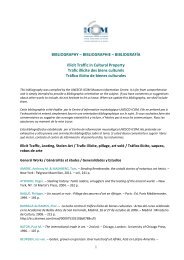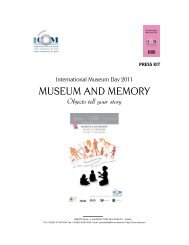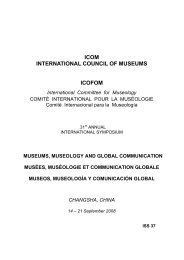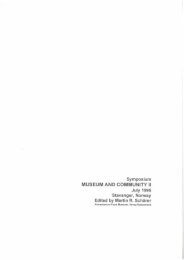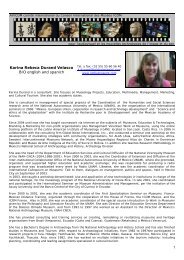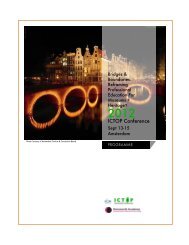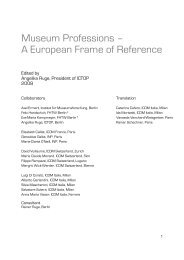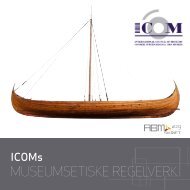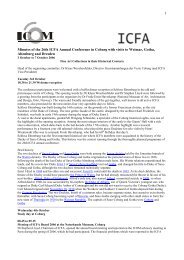Key Concepts of Museology - ICOM
Key Concepts of Museology - ICOM
Key Concepts of Museology - ICOM
Create successful ePaper yourself
Turn your PDF publications into a flip-book with our unique Google optimized e-Paper software.
36<br />
interactions specifi c to this place, or<br />
to all the images and ideas that this<br />
place might evoke.<br />
2. As a result <strong>of</strong> the act <strong>of</strong> displaying,<br />
exhibitions are seen today<br />
as one <strong>of</strong> the main functions <strong>of</strong> the<br />
museum which, according to the<br />
latest defi nition by <strong>ICOM</strong>, “acquires,<br />
conserves, researches, communicates<br />
and exhibits the tangible and intangible<br />
heritage <strong>of</strong> humanity…” According<br />
to the PRC model (Reinwardt<br />
Academie), exhibition is part <strong>of</strong> the<br />
museum’s more general function <strong>of</strong><br />
communication, which also includes<br />
policies for education and publication.<br />
From this point <strong>of</strong> view exhibitions<br />
are a fundamental feature<br />
<strong>of</strong> museums, in so far as these prove<br />
themselves to be excellent places for<br />
sensory perception, by presenting<br />
objects to view (that is, visualisation),<br />
monstration (the act <strong>of</strong> demonstrating<br />
pro<strong>of</strong>), ostention (initially the<br />
holding up <strong>of</strong> sacred objects for adoration).<br />
The visitor is in the presence<br />
<strong>of</strong> concrete elements which can be<br />
displayed for their own importance<br />
(pictures, relics), or to evoke concepts<br />
or mental constructs (transubstantiation,<br />
exoticism). If museums can be<br />
defi ned as places <strong>of</strong> musealisation<br />
and visualisation, exhibitions then<br />
appear as the “explanatory visualisation<br />
<strong>of</strong> absent facts through objects,<br />
and methods used to display these,<br />
used as signs” (Schärer, 2003). Showcases<br />
and picture rails are artifi ces<br />
which serve to separate the real<br />
world and the imaginary world <strong>of</strong><br />
museums. They serve no other role<br />
than to mark objectivity, to guarantee<br />
distance (creating a distancing,<br />
as Bertolt Brecht said <strong>of</strong> the theatre)<br />
and let us know that we are in another<br />
world, a world <strong>of</strong> the artifi cial,<br />
<strong>of</strong> the imaginary.<br />
3. Exhibitions, when they are<br />
understood as the entirety <strong>of</strong> the<br />
objects displayed, include musealia,<br />
museum objects or “real things”,<br />
along with substitutes (casts, copies,<br />
photos, etc.), display material (display<br />
tools, such as show cases, partitions<br />
or screens), and information tools<br />
(such as texts, fi lms or other multimedia),<br />
and utilitarian signage. From<br />
this perspective the exhibition works<br />
as a specifi c communication system<br />
(McLuhan and Parker, 1969; Cameron,<br />
1968) based on “real things”<br />
and accompanied by other artefacts<br />
which allow the visitor to better identify<br />
their signifi cance. In this context,<br />
each <strong>of</strong> the elements present in the<br />
exhibition (museum objects, substitutes,<br />
texts, etc.) can be defi ned as an<br />
exhibit. In such a situation it is not a<br />
question <strong>of</strong> rebuilding reality, which<br />
cannot be relocated in the museum<br />
(a “real thing” in a museum is already<br />
a substitute for reality and an exhibition<br />
can only <strong>of</strong>fer images which<br />
are analogous with that reality). The<br />
exhibition communicates reality<br />
through this mechanism. Exhibits in<br />
an exhibition work as signs (semiotics),<br />
and the exhibition is presented<br />
as a communication process which<br />
is most <strong>of</strong>ten unilateral, incomplete<br />
and interpretable in ways that are<br />
<strong>of</strong>ten very different. The term exhi-



